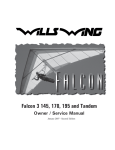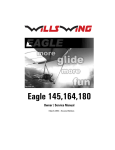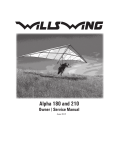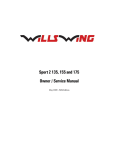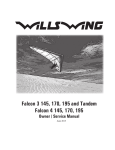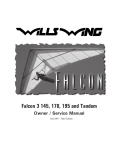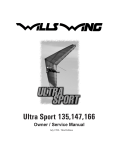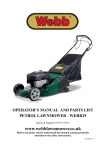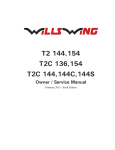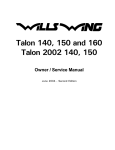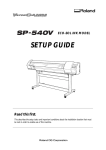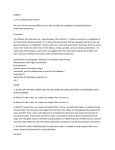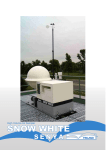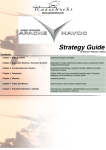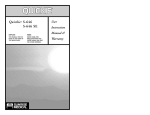Download RamAir OM - Wills Wing
Transcript
154 - 146 Owner / Service Manual Copyright © 1993 by Sport Kites, Inc. dba Wills Wing, Inc. All rights reserved. No part of this manual may be reproduced in any form without the express written permission of Sport Kites, Inc., dba Wills Wing, Inc. Revised 3/24/94 - 5th Edition 500 West Blueridge Ave Orange, CA 92665 Phone (714) 998-6359 FAX (714) 998-0647 1 Table Of Contents Page Introduction ........................................................................................................ 3 Disclaimer and Warning ..................................................................................... 4 Technical Information and Placarded Operating Limitations ............................... 4 - 6 Shipping Breakdown and Re-Assembly ............................................................. 7 - 9 Glider Set-Up and Preflight ................................................................................ 9 - 22 Launching and Flying .......................................................................................... 23 Trimming The Glider In Pitch and Speeds to Fly ................................................ 23 - 27 Using The VG System ....................................................................................... 28 - 29 Landing .............................................................................................................. 29 - 31 Breakdown ........................................................................................................ 31 - 32 Stability Systems ............................................................................................... 32 - 38 Maintenance ...................................................................................................... 38 - 39 Removing and Re-Installing The Sail .................................................................. 39 - 42 Tuning ................................................................................................................ 42 - 43 Car Top Mounting .............................................................................................. 43 Closing Message ............................................................................................... 44 Compliance Verification Specification Sheets ..................................................... 46 - 47 Frame Plans and Exploded Views ..................................................................... 48ff 2 INTRODUCTION Thank you for purchasing a Wills Wing glider, and welcome to the world wide family of Wills Wing pilots. We are a company of pilots and aviation enthusiasts, and our goal is to serve your flying needs now and in the future, as we have done for pilots throughout the world since 1973. We encourage you to read this manual thoroughly for information on the proper use and maintenance of your Wills Wing glider. If at any time you have questions about your glider, or about any aspect of hang gliding that your Wills Wing dealer cannot answer, please feel free to give us a call. We wish you a safe and enjoyable flying career, and, once again, welcome aboard! Rob Kells, Mike Meier, Linda Meier, and Steve Pearson Wills Wing, Inc. 3 DISCLAIMER AND WARNING Hang gliding is a form of aviation. Like any form of aviation, its safe practice demands the consistent exercise of pilot skill, knowledge of airmanship and weather, judgment and attention at a level which is appropriate to the demands of each individual situation. Pilots who do not possess or exercise the required knowledge, skills and judgment are frequently injured and killed. The statistical rate at which fatalities occur in hang gliding is approximately one per thousand participants per year. The Federal Aviation Administration does not require a pilot’s license to operate a hang glider. Hang gliders and hang gliding equipment are not designed, manufactured, tested or certified to any state or federal government airworthiness standards or requirements. Federal Aviation Regulation Part 103 states in part, "ultralight vehicles are not required meet the airworthiness certification standards specified for aircraft or to have certificates of airworthiness" and "operators of ultralight vehicles are not required to meet any aeronautical knowledge, age, or experience requirements to operate those vehicles or to have airman or medical certificates." Wills Wing hang gliding products are not covered by product liability insurance. As a hang glider pilot, you are entirely responsible for your own safety. You should never attempt to fly a hang glider without having received competent instruction. We strongly recommend that you not participate in hang gliding unless you recognize fully and wish to personally assume all of the associated risks. Please fly safely. Wills Wing, Inc. TECHNICAL INFORMATION AND PLACARDED OPERATING LIMITATIONS The RamAir 154 and 146 have been tested and found to comply with the 1993 Hang Glider Manufacturers Association (HGMA) Airworthiness Standards. These standards require: 1) A positive load test at root stall angle of attack at a speed equal to at least the greatest of: a) 141% of the placarded maximum maneuvering speed b) 141% of the placarded maximum rough air speed c) 123% of the placarded speed never to exceed for at least three seconds without failure. The required speed for the RamAir 154 and 146 for this test was 74 mph. 2) A negative 30 degree angle of attack load test at a speed equal to at least the greatest of: a) 100% of the placarded maximum maneuvering speed b) 100% of the placarded maximum rough air speed c) 87% of the placarded speed never to exceed for at least 3 seconds without failure. The required speed for the RamAir 154 and 146 for this test was 52 mph. 4 3) A negative 150 degree angle of attack load test at a speed equal to at least the greater of 30 mph or 50% of the required positive load test speed for at least 3 seconds without failure. The required speed for the RamAir 154 and 146 for this test was 37 mph. 4) For the RamAir 154 and 146, with a Vne of 60 mph, pitch tests at speeds of 20 mph, 40 mph and 60 mph which show the glider to be stable over a range of angles of attack from trim angle to 20 degrees below zero lift angle at 20 mph, and from trim angle to 10 degrees below zero lift angle at 40 mph, and from 10 degrees above zero lift angle to zero lift angle at 60 mph. 5) Flight maneuvers which show the glider to be adequately stable and controllable throughout the normal range of operation. NOTE: The RamAir 154 and 146 have been designed for foot launched soaring flight. They have not been designed to be motorized, tethered, or towed. They can be towed successfully using proper procedures. Pilots wishing to tow should be USHGA skill rated for towing, and should avail themselves of all available information on the most current proper and safe towing procedures. Suggested sources for towing information include the United States Hang Gliding Association and the manufacturer of the towing winch / or equipment being used. Wills Wing makes no warranty of the suitability of the glider for towing. Flight operation of the RamAir should be limited to non aerobatic maneuvers; those in which the pitch angle will not exceed 30 degrees nose up or nose down from the horizon, and the bank angle will not exceed 60 degrees. The RamAir is generally resistant to spinning, but will spin from a stalled turn if the VG is adjusted at or near the tight end of the range, and the rate of application of pitch is moderately rapid. The RamAir can be induced to spin at any VG setting. Recovery from a spin requires unstalling of the wing, and it is therefore critically important that in the event of a spin, no application of nose up pitch control be held. The RamAir will recover from a spin once control pressures are relaxed. As the nose lowers and the angle of attack is reduced, the stall will be broken and the spin will stop. However, such recovery will consume significant altitude, and will result in the glider assuming an unpredictable heading. Recovery from a spin may therefore involve a flight trajectory which intersects the terrain at a high rate of speed. An aggravated spin could result in loss of control, in flight inversion, and structural failure. Therefore no attempt should ever be made to deliberately spin the glider. The RamAir provides the pilot with a high degree of pitch authority, in combination with a very low twist sail. As a result, it is possible by pushing fully out on the bar to produce a very aggravated and severe stall, the recovery from which may involve very severe pitch down rotation, the pilot going weightless, and the glider recovering via an unpredictable trajectory with a significant altitude loss. Therefore, full arms extension aggravated stalls should not be induced except on landing flare. The maximum steady state speed for a prone pilot in the middle of the recommended weight range full forward on the control bar with the VG set full tight is approximately 63 mph for the RamAir. The placarded speed never to exceed for the RamAir is 60 mph. This speed will be achieved with the control bar basetube approximately two inches below the waist. The placarded maximum maneuvering speed, and the placarded maximum rough air speed of the RamAir are each 52 mph. This speed will be achieved with the control bar basetube 5 approximately four inches above the waist. This speed should not be exceeded in anything other than smooth air. No abrupt maneuvering or control inputs should be made at anything above this speed. The stability, controllability, and structural strength of a properly maintained RamAir have been determined to be adequate for safe operation when the glider is operated within all of the manufacturer specified limitations. No warranty of adequate stability, controllability, or structural strength is made or implied for operation outside of these limitations. The stall speed of the RamAir at maximum recommended wing loading is 25 mph or less. The top (steady state) speed at minimum recommended wing loading for a prone pilot with a properly designed and adjusted harness is at least 46 mph. All speeds given above are indicated airspeeds, for a properly calibrated airspeed indicator mounted in the vicinity of the pilot. Wills Wing provides such an airspeed indicator with the glider. It is strongly recommended that the pilot fly with such an airspeed indicator. Refer to the section on using the airspeed indicator for further information on speeds to fly. The recommended hook in pilot weight range for the RamAir is: RamAir 154: 160 - 270 lbs. RamAir 146: 145 - 260 lbs. Be advised that pilots with hook in weights of less than 20 lbs above minimum will find the RamAir significantly more demanding of pilot skill to fly, and that pilots hooking in within 20 lbs of the maximum will experience some relative degradation of optimum sink rate performance due to their higher wing loading. A minimum USHGA Advanced (IV) level of pilot proficiency is required to fly the RamAir safely. Pilots are advised that the optimum proficiency level for the RamAir is higher than the minimum recommended. Operation of the glider by unqualified or under qualified pilots may be dangerous. Operating the RamAir outside of the above limitations may result in injury and death. Flying the RamAir in the presence of strong or gusty winds, or turbulence may result in loss of control of the glider which may lead to injury and death. Do not fly in such conditions unless you realize and wish to personally assume the associated risks. Wills Wing is well aware that pilots have, and continue to perform maneuvers and fly in conditions which are outside the recommended operating limitations stated herein. Please be aware that the fact that some pilots have exceeded these limitations in the past without dangerous incident does not imply or insure that the limitations may be exceeded without risk. We know for a fact that gliders which meet all current industry standards for airworthiness can and do suffer in flight structural failures, both as a result of turbulence, and as a result of various maneuvers outside the placarded operating limitations, including, but not necessarily limited to aerobatics. We do not know, and cannot know, the full range of maneuvers or conditions which may cause the pilot’s safety to be compromised, nor can we test the glider in all possible circumstances. 6 RamAir BREAKDOWN PROCEDURE FOR SHIPPING AND RE-ASSEMBLY PROCEDURE The RamAir 154 can be broken down to approximately 13.5 feet by removal of the rear leading edges. STOP: DO NOT REMOVE ANY OF THE CLEVIS PINS OR SCREWS IN THE VICINITY OF THE REAR LEADING EDGE STEP DOWN JUNCTION. 1) The front leading edge of the RamAir is 60 mm (2.36") tubing, into which slides the rear leading edge of 50 mm (1.97") tubing, with an overlap of 6". Because of the great difference in diameters of the front and rear leading edges, they are not concentric; that is they do not share a common axial centerline. Instead, the 50 mm and the 60 mm tubes are tangential (they contact each other) on a line along the forward edge of the leading edge, just below the horizontal centerline. (See diagram).Inside the 60 mm front leading edge, six inches from the rear end, is a 58 mm diameter ryton plastic crescent reducer which is secured in place by a 3/16" clevis pin which passes all the way through the 60 mm front leading edge. (See diagram). DO NOT REMOVE THIS PIN. A second crescent in located at the aft end of the 60 mm front leading edge, where the 50 mm rear leading edge exits. This crescent is held in place with a screw. DO NOT REMOVE THIS SCREW EITHER. A reinforcing inner sleeve is located inside the 50 mm rear leading edge, and is secured in place by a clevis pin. DO NOT REMOVE THIS PIN EITHER. The rear leading edge is slotted at it’s forward end, such that the slots engage around the clevis pin which secures the forward crescent. STOP: THE REAR LEADING EDGE WILL PROPERLY ENGAGE THE CLEVIS PIN IN ONLY ONE AXIAL ORIENTATION. IF INSERTED WITH 180 DEGREES ROTATION, IT MAY SEEM TO BE ENGAGING, DUE TO THE FLARE AT THE ENDS OF THE SLOTS. HOWEVER, FORCING THE TUBE IN IN THIS ORIENTATION WILL DAMAGE THE TUBE, SPLITTING THE SLOT OPEN. 7 TO BREAK DOWN THE LEADING EDGES FOLLOW THESE STEPS: 1) Lay the glider on the ground or floor, unzip and remove the bag and remove the velcro ties. Undo the velcros which hold the sail around the sail mount plug and pull the sail rearward at each tip to dismount the sail from the rear leading edge. 2) Obtain an indelible marker. Mark the rear leading edges left and right (remember that left and right are reversed if the glider is lying “on it’s back”, upside down. Push the sail up to where you have uncovered the point where the rear leading edge exits the front. Trace around the circumference of the 50 mm rear leading edge just along the aft face of the crescent reducer so as to mark the point at which the rear leading edge is fully engaged in the front. 3) Scribe a line along the leading edge which crosses the front to rear leading edge junction at the point on the circumference where the front and rear leading edges are tangent. This will help to align the rear leading edge during re-assembly. 4) On a late model sail (after September 1993) the mylar can be removed at this time. Remove the top plastic kingpost cap and disconnect the top side wire from the kingpost. Replace the cap. Pull the top side wire through to the inside of the sail. Pull the sail back down the length of the leading edge but do not remount it to the rear. Pull the mylar out from the rear of the mylar pocket, curling it under where it exits so that it will fit through the opening. If the mylar sticks, work up and down the edges of the mylar along the mylar pocket, breaking the edges of the mylar away from the seamstick tape in the seams. (On early model sails, the myar can only be removed with the sail completely off the frame by sliding it out of the front of the mylar pocket from inside the double surface through the bottom surface center zipper.) 5) Spray silicone spray lubricant on the rear leading edge at the point where it exits from the front. 6) Pull the rear leading edge straight aft to disengage it from the front. Put tape on the sharp edges of the front end of the rear leading edge tubes. 7) Carefully fold the rear of the sail over against the front, and replace the bag on the glider. 8 RE-MOUNTING THE REAR LEADING EDGES 1) Make sure you are mounting the correct leading edge rear into the correct front (check the “right” / “left” designation. 2) Spray the forward six inches of the rear leading edge with silicone spray lubricant. 3) Slide the rear leading edge into the front, lining up the rotational alignment marks you made during breakdown, until the rear engages fully in the front leading edge, as indicated by the circumferential scribe made at the exit point of the rear leading edge during breakdown. 4) Pull the sail down the leading edge and re-install the mylar if removed. The mylar is most easily installed by attaching it to a long pole and pushing it into the pocket. 5) Re-install the top side wire if removed. 6) Remount the sail to the rear leading edge, making sure to align the sail mount webbing squarely in the slot and attach the securing velcros. STOP: THE SAIL IS MOUNTED TO THE LEADING EDGE BY THE INNER (FORWARD) OF THE TWO LOOPS OF WEBBING. THE OUTER LOOP IS A PULL HANDLE ONLY. You may find it helpful to use a large, flat bladed screw driver to pry the sail mount webbing over the end of the leading edge tube and into the slot. Take care not to damage the webbing. 9 RAMAIR Set-Up Procedure The RamAir has been specially designed to set up quickly and easily either on the control bar or flat on the ground. We will first cover the steps for setting up on the control bar. 1) Lay the glider on the ground, with the bag zipper up, with the nose into the wind. 2) Undo the zipper, remove the battens, remove the protective pad at the rear wire station on the keel, and remove the control bar bag. 3) Unfold the control bar legs and straighten the fold in the folding basetube. Preflight the folding basetube center hardware at this time, checking that the nuts and coil spring pins are secure, and that the tangs are straight and in good condition. Slide the basetube center sleeve over the center joint until it is positioned between the button spring pins. (Note: If you plan to clamp instruments to the basetube center, position the center sleeve so that one button passes through the hole near one end of the sleeve, which will secure the sleeve against rotation. 4) Grasp the swan lever, attached to the forward end of the swan catch wire, and pull it towards the nose while holding the basetube and keeping the control bar aligned as nearly 10 centered side to side with the keel as possible. The control bar apex bracket will slide on the keel track until it comes up against the stop at the forward end of the track. If the apex slider resists sliding forward, wiggle the basetube back and forth slightly to free it. STOP: If the apex bracket will not slide forward, check to see that a bottom side wire is not hooked around the head of the keyhole bolt at the rear wire station on the keel. 5) Insert the rounded end of the swan catch lever (without the thumb handle extension) into the rear pin channel in the swan catch bracket on the bottom of the noseplate. (The pin should be retracted and held in place by the flat swan spring. If it is not, retract the pin first). As the swan lever end depresses the flat swan spring, the spring loaded swan catch pin will be released. Align the hole in the lever with the pin, and allow the pin to slide through the lever and through the other side of the swan catch channel. 11 STOP: Make sure that the rear swan catch pin is fully engaged in the swan lever, and passes through and extends beyond the other side of the channel. An inadvertent release of the swan lever from the swan catch channel in flight will allow the control bar apex to slide rearwards causing a total lack of structural support for the wings and a complete loss of control of the glider. 6) Flip the glider upright and set it on the control bar, and remove the glider bag and all velcro sail ties. Loosen the velcro attachments on the tip cover bags, but do not remove the bags at this time. If there is more than eight mph of wind, or if the wind is gusty, turn the glider 90 degrees to the wind direction. 7) Spread the wings almost all the way. If you have left the bridles attached, this will automatically stand the kingpost upright. If not, lift on the top side wire as you spread the second wing, and the kingpost will stand up. 8) If the bridles have been detached, attach the bridle ring to the snap hook at this time, taking care that there is not a twist or rotation in the bridle ring which causes the bridle line to cross over one another. 9) Remove the battens from the batten bag, and check each batten for symmetry against the corresponding batten from the other wing. Wills Wing convention is that black tipped battens go in the right wing and white tipped battens in the left, except for the straight #1 plug on battens which all have black tips. 10) Install the cambered top surface battens in the sail, leaving out the shortest two on each side (#2 and #3) for now. Each batten is secured by a double loop of the batten string. 12 Order of insertion is longest to shortest, from the root out. When inserting the inboard most battens, lift the keel to ease the insertion. When these battens reach the back side of the leading edge tube, it may be necessary to lift the sail along the batten pocket to facilitate insertion of the batten all the way. STOP: Insert the battens carefully, so as to minimize stress and wear on the sail. Never insert or remove top surface battens with the crossbar tensioned (except for up to the last four on each side) and never insert or remove battens with heavy wind pressure on the top of the sail or in any condition which causes the battens to slide with great resistance in the pockets. 11) Spread the wings all the way and check all cables for any twisted thimbles or tangled cables. Check at this time that no bridle line is caught under the end of an adjacent batten. 13 12) At the rear of the keel, tension the crossbar by pulling on the top portion of the 4mm accessory cord which passes through the white pulley on the rear of the sweep wire keyhole channel. Drop the keyhole channel all the way down over the head of the keyhole bolt, and let it slide forward into the locked position. STOP: Never install the keyhole channel onto the keyhole bolt without making absolutely sure that the channel is fully engaged on the narrow neck of the bolt and slid forward into the fully locked position. An inflight disengagement of this attachment will cause a complete loss of structural support of the glider and a total loss of control. 13) Remove the wingtip protector bags, and remove the plastic wingtip fairings from inside the bags. Install the last two curved battens on each side. 14 14) Install the plug-on #1 battens by inserting one end through the hole in the bottom surface at the tip and engaging the forked batten tip on the clevis pin standoff on the back side of the leading edge. Secure with a double loop of the 505 batten string. 15) At this time preflight the following from the open end of the wingtip: a) The sail mount webbing - make sure that the inner loop of webbing is laying flat in the bottom of the slot in the sail mount endcap. b) The number one batten clevis pin and safety. c) The clevis pin and safety just aft of the leading edge step down which secures the 48 mm inner sleeve in the rear leading edge. d) The aft crescent reducer - make sure it is fully engaged in the 60 mm front leading edge tube. e) The front crescent reducer clevis pin and safety. f) The crossbar / leading edge junction bolt castle nut and safety. 16) Install the plastic wing tip fairing. Before doing so, separate the neoprene from the velcro to provide a space for the edge of the fairing to fit. Make sure that the fairing lodges between the inside of the sail and the outside of the neoprene seal, and that the fairing is fully inserted into the leading edge such that the velcro mates securely around the entire perimeter of the tip fairing. While installing the tip fairing, support the aft tip of the number one batten as necessary so as to equalize the tension around the perimeter of the open end of the sail at the wing tip to insure that the sail mates properly to the tip fairing. 15 17) Go to the nose and tension the swan catch wire. This is most easily done by placing a thumb under the lever handle on the swan lever and then pulling downwards on the swan lever cable to pull the control bar apex slider fully forward against the stop. Then, as you release tension on the cable, rotate the swan lever forwards and up until it clicks fully into place and the forward spring loaded swan pin slides all the way through both the lever and the hole in the far side of the channel. (This pin should have been held retracted by the flat swan spring; if it was not, retract it before performing this operation.) STOP: Make sure that the forward swan catch pin is fully engaged in the hole in the swan lever, and passes through and extends beyond the other side of the channel. An inadvertent release of the swan lever from the swan catch channel in flight will allow the control bar apex to slide rearwards causing a total lack of structural support for the wings and a complete loss of control of the glider. Flying the glider with the front end of the swan lever detached will slacken the wires on the glider reducing glider stability and control. 18) By lifting up and back on the nose batten strings, push the nose battens fully back into the sail so that the tips rest on top of the noseplate. Look into the noseplate and pre-flight the nosebolt nuts and the safety on the bolt securing the top front wire. 19) Install the nosecone taking care to align it so that it lies flat on the top and bottom of the sail. 16 20) Install the bottom surface battens, inserting the end with the flat bladed plastic tip and the metal sleeve into the pocket first. 21) Install the RamAir inlet scoop over the port on the bottom surface near the nose. Reach in through the port to press the velcro surfaces together to make sure they are mated securely. 22) Conduct a complete preflight of the glider, checking all assemblies which have not already been checked: ALONG THE LEFT LEADING EDGE: Carefully check the entire length of the leading edge pocket to insure that the mylar insert is lying flat in the pocket. If any section of the mylar is folded under, de-tension the crossbar, remove the batten closest to the area of distortion, and unfold the mylar. Failure to correct such a problem will cause a severe alteration of the flight characteristics of the glider which may lead to a dangerous loss of control. 17 While pushing up on the leading edge between the nose and the crossbar junction, step on the bottom side wire with about 75 lbs. of force. This is a rough field test of the structural security of the side wire loop, the control bar, the kingpost, and the crossbar, and may reveal a major structural defect that could cause an inflight failure in normal operation. Open the crossbar junction access zipper and look inside, making sure that the safety ring on the junction bolt is in place and that the wires are secure and properly routed. Re-close the zipper. At the left wingtip: You have already preflighted those parts of the glider accessible only with the tip fairing removed. At this time, check the tip again for secure and proper installation. ALONG THE TRAILING EDGE, LEFT WING: Check that there are no tears in the sail material along the trailing edge. 18 Check that all batten strings are properly secured. Check that the bridles are properly engaged, with the plastic retainer balls fully seated against the grommet, and that no bridle cable is hooked underneath a more inboard batten. Wrong! FROM THE REAR KEEL: Stretch the elastic webbing seal fully upwards along the kingpost. Through the opening in the rear of the seal, check the two nuts on the top of the kingpost base bracket which secure the bracket to the keel. Check the condition of the kingpost base compensator pulleys, and check that the lower compensator cables are properly routed around the pulleys and are in good condition. Pull the top edge of the seal away from the kingpost and check the nut on the bolt which secures the kingpost bottom tangs to the bracket, and the pin, safety, and rivets which secure the tangs to the kingpost. Check the condition of the sweep wires in the vicinity of the kingpost base bracket. Check the kingpost top for proper attachment of the bridles and condition and routing of the upper compensator cable. Check again that the keyhole channel is fully engaged and locked to the keyhole bolt. 19 ALONG THE TRAILING EDGE, RIGHT WING: Same as for left wing. AT THE RIGHT TIP: Same as for left tip. ALONG THE RIGHT LEADING EDGE: Same as for left leading edge. UNDER THE GLIDER, AT THE CONTROL BAR: Sight down the downtubes, making sure that they are straight. Check the cables at the control bar corners, making sure there are no kinks or twisted thimbles. Check for proper installation of all nuts and safety rings at the control bar corners. Check the routing of the VG rope around the base bracket pulley, and around the control bar top pulley, and check the VG operation. Pull back the neoprene protectors and check the control bar apex bracket hardware, including the clevis pin safeties, the control bar top plug bolts and nuts, and the elbow to apex slider bolt and nut. Check the main and backup hang loops: a) Check all three oval quick links to insure that the screw gate is fully closed. Check to be sure the quick links are properly aligned so that the pull is along the long axis, and that the clear plastic sleeves are in place over the links to maintain their alignment. b) Check that the backup is properly positioned circumferentially around the main, and that the backup is secured to the main by the matching velcro surfaces. This will insure that the quick link on the backup is not positioned at the bottom of the loop. c) Check that the longitudinal CG adjustment strap is secure - that both front and rear tangs are securely bolted down to the keel. d) Check that the VG rope passes outside the hang loops. 20 STOP ! These quick links have been tested to more than 3000 lbs, but will only have full rated strength if in good condition, if fully closed and properly oriented. Using these links, the main loop has been tested to more than 6000 lbs. and the backup has been tested to more than 7000 lbs. Never use a wrench to force closed a quick link on which the threads have been damaged - replace the link. You may use a wrench to tighten the link the last 1/4 turn after finger tight. STOP! DO NOT USE any hang loop other than the type installed on your RamAir from the factory. In particular, do not use a hang loop which is looped through itself and cinched tight to the keel, and this can cause bending fatigue and eventual failure of the swan lever wire. Open the center zipper and check the routing of the VG rope around the pulleys, and that the pulleys are properly aligned and not twisted or tangled. Check the attachment of the lower compensator line to the crossbar center pull back cable. Check that the front keel pocket is secured to itself with the mating velcro surfaces, and that all VG cables and ropes (but not the swan lever cable or swan lever cable bungee) are inside the keel pocket. STOP! Whenever you undo the velcro attaching the two sides of the front keel pocket to one another, you must be sure when re-attaching them that the sweep wires are fully inside the keel pocket. Otherwise the keel pocket can be caught in the "V" between the sweep wire and VG pulley pigtail when the wings are folded in during breakdown, and the keel pocket can be ripped away from the sail. 21 STOP! INSPECT THE APEX SLIDER TO VERIFY THAT THE EARS HAVE NOT BEEN BENT IN A HARD LANDING, AND THAT THE BOTTOM AND SIDE PLASTIC SLIDES ARE PROPERLY IN PLACE. Under the glider behind the control bar apex: Check that the root battens are engaged in all segments of the batten pockets and in the two webbing loops which pass through the bushed horizontal holes in the rear keel. Check that the keel mounted VG rope re-direction pulley is secure, and that the nuts on the securing bolts are tight. LAYING THE GLIDER DOWN FLAT Once the glider is assembled it can easily be laid down flat on the ground. Detach the bottom of the nose cone. Pull down on the swan lever cable to slacken it, and then release the forward swan lever pin. Support the nose of the glider and release the rear swan lever pin. If the control bar apex does not immediately slide aft, push gently on one control bar leg with your foot. As the apex slides aft, lower the nose of the glider to the ground. Reverse the procedure to set the glider upright again. SETTING THE GLIDER UP FLAT ON THE GROUND In areas where the ground is not rocky and when there are strong winds, you may wish to set up the glider flat on the ground. This is easy to do, and relatively few parts of the set up procedure are different from what has been described. 1) After unfolding the control bar and securing the basetube center sleeve, flip the glider over right side up with the control bar still flat under the glider. 22 2) Spread the wings and install all the battens and the wingtips. (Note: Perform all the normal preflight operations as described above). 3) Tension the crossbar. 4) Install the RamAir inlet scoop. 5) When ready, raise the nose of the glider while pulling on the swan cable by the swan lever to raise the glider up onto the control bar. Secure and tension the swan lever as described above. 6) Install the nosecone. LAUNCHING AND FLYING THE RAMAIR STOP! Before launching, hook in to the glider and do a careful hang check. 1) We recommend that you launch with the VG set between full loose and 1/3 on. The looser position gives better roll control once airborne, but not as good control of the roll attitude of the glider on the ground due to the increased slack in the side wires. Stop: If you launch with the VG set partly on, you must make sure that there is no way that the excess VG rope can catch on anything on the ground or that you can step on it. One way to do this is to fold the rope into a flat loop about eight inches long, and tuck it around the outside of the right downtube above the bottom front, rear, and side wires. If the wind is more than 10 mph or gusty you should have an assistant on your nose wires on launch, and, if necessary, an assistant on one or both side wires. Make sure all signals are clearly understood. The angle at which you hold the glider should depend on the wind speed and slope of the terrain at launch; you want to achieve a slight positive angle of attack at the start of your run. 2) Run aggressively on launch and ease the bar out for lift off. 3) The flying characteristics of the RAMAIR are typical of a high performance flex wing. Make your first flights from a familiar site in mellow conditions to give you time to become accustomed to the glider. 4) We recommend that you hang as close as possible to the basetube in the glider - this will give you lighter control pressures and better control. USING WING TUFTS Your Wills Wing glider has been equipped from the factory with short yarn tufts on the top surface of each wing. The shadow of these tufts will be visible through the sail. The tufts are useful for indicating the local reversal of the airflow which is associated with the onset of the stall in that portion of the wing. You can use these tufts, as described below, to help determine when you are flying at minimum sink airspeed. 23 There are two important airspeeds with which all hang glider pilots should be intimately familiar; minimum sink airspeed (hereinafter referred to as MSA) and minimum controllable airspeed (MCA). The most important of these two is MCA. Minimum sink airspeed is that speed at which your descent rate is the slowest possible. It is the speed to fly when you want to maximize your climb rate in lift, or slow your rate of descent to a minimum in non lifting air. (You would normally not fly at MSA in sinking air; the strategy there is normally to speed up and fly quickly out of the sink. By minimizing your time spent in the sinking air you minimize altitude lost, even though you have momentarily increased your sink rate by speeding up.) Minimum controllable airspeed is that speed below which you begin to rapidly lose effective lateral control of the glider. Recognition of this speed and its implications is a more subtle problem than many pilots realize. We have seen several instances of pilots who were having a lot of trouble flying their gliders simply because they were unknowingly trying to fly them too slowly; below the speed at which the glider responded effectively to lateral control inputs. It is our opinion that a great percentage of hang gliding accidents are caused by inadvertent flight below MCA, and subsequent loss of control of the glider with impact preceding recovery. Such incidents are usually attributed to “stalls,” but it is not the stall per se that causes the problem, indeed the glider need not even be “stalled” in the traditional sense. There is no necessary cause and effect relationship between minimum sink speed and minimum controllable airspeed. MSA is determined primarily by the wing loading and span loading, the wing planform, the wing section characteristics, etc. MCA is influenced most heavily by the tension in the sail; how much “billow” the glider has. However, in your Wills Wing glider, as in most hang gliders, MCA and MSA evolved towards a common value during the design and development of the glider. This is so because if the wing is tuned so tight that minimum controllable airspeed is at a higher speed than minimum sink speed, then effective sink rate performance can be improved by loosening the wing so as to lower the minimum controllable airspeed. Conversely, if minimum controllable airspeed is reached at a speed below that of minimum sink, the wing can usually be tightened so as to improve glide performance without significant sacrifice in other areas. USING WING TUFTS TO FIND THE MINIMUM SINK SPEED OF YOUR GLIDER On a flex wing hang glider, the wing experiences a gradual and progressive stall, and different spanwise stations of the wing stall at different angles of attack. Contrary to popular belief, a hang glider wing does not stall first in the root or center section. It is true that because of wing twist the root section is at the highest angle of attack relative to the remote free stream airflow, but other factors influence the stall propagation on the wing. Specifically, a flex wing hang glider stalls first somewhere outboard of the root on each wing, approximately one fifth to one third of the way out from the root to the tip, where your tufts are located. As the angle of attack is raised further, the stall propagates both outward towards the tips and inward towards the root. If you wish to observe the stall propagation across the whole wing on your glider, you can cut some more tufts from knitting yarn, about 3-4" long, and tape these to the top surface of your sail across the rest of the span. During normal flight the flow will be chordwise along the wing, and the tufts will point towards the trailing edge. When the wing stalls, the tufts will reverse direction, indicating the local flow towards the leading edge. 24 At the first onset of stall, the tufts will sometimes indicate the impending separation by first wiggling, and then deflecting spanwise, before they fully reverse and point forward. The first onset of stall in the midspan occurs well before the familiar “stall break” in which the glider pitches uncontrollably nose down to recover from the stall. By the time the stall break occurs, all tufts but those farthest outboard and those farthest inboard will have indicated reversed flow. The first onset of midspan stall as indicated by the first tickling of the tufts indicates that you have reached the angle of attack corresponding to the glider’s minimum sink airspeed. This will also be very close to the glider’s minimum controllable airspeed. To find the glider’s minimum sink speed, fly the glider in smooth air, early in the morning or late in the afternoon. When you are well away from the terrain, and well clear of other aircraft, look up at the wing tufts while you very gradually reduce the speed of the glider. Note the speed at which the first tuft first begins to wiggle just prior to blowing spanwise toward the tip. (If the tufts contain static electricity, they may not show this lateral wiggle prior to reversal. However, you may get other clues to the beginning of separation, such as slight flutter or rumble in the top surface of the sail.) This is your speed for minimum sink rate. Familiarize yourself with the position of the control bar relative to your body at this speed, with the sound and feel of the wind, with the reading on your airspeed indicator, and with the feel of the glider in terms of pitch and roll pressures. Most of the time when you are flying it will not be practical to look up for extended periods of time at your tufts. That is why familiarization with these other, more accessible indicators is important. After finding your minimum sink speed, experiment with roll control response at speeds just above and just below this speed to find the value of MCA and the corresponding bar position and other indicators for this speed. Realize that your effective MCA is going to be higher and higher as the air becomes more and more turbulent; control response that is perfectly adequate in smooth air will not be good enough in rougher air. Try flying the glider with the midspan tufts fully reversed; you will probably find that the glider is somewhat controllable, but only with a lot of physical effort. Note that both MCA and MSA come well before the glider actually “stalls” in the traditional sense, i.e. pitches uncontrollably nose down. You may also be able to sense, or your vario may tell you that although the glider has not “stalled” (pitched nose down) your sink rate has increased significantly. In this mode the glider is “mushing.” Once you have familiarized yourself with the glider’s characteristics in this range of speeds, you will not need to look at the tufts very often. You will know from bar position and bar pressure, and from the sound and feel of the relative wind when you are at your minimum sink / minimum controllable airspeed. In general, you should not fly your glider below this speed. Be aware, however, that when you are flying at minimum sink in thermal gusts and turbulence, you will experience gust induced separation of the airflow which will periodically cause the tufts on your sail to reverse. Of course in a turn, your minimum sink SPEED goes up because you are banked, and the bank effectively increases your wing loading which increases your flying SPEED for any angle of attack. But note this: THE TUFTS INDICATE ANGLE OF ATTACK, WITHOUT REGARD TO AIRSPEED! Therefore, if you practice flying various bank angles in smooth air 25 (while well away from any terrain or other gliders) and watch your tufts (on the inside wing, which will be at the highest angle of attack) you will get a feel for the way your minimum sink speed varies at varying bank angles. Also be aware that in some thermalling situations, such as when trying to maximize climb rate in a thermal with a very strong and very small core, there may be an advantage in overall effective climb performance to flying so slowly that some portion of the inside wing is partially stalled most of the time. This is, however, an advanced and potentially dangerous technique - it is the beginning of a spin entry, and if pushed just a little too far can result in a sudden and extreme loss of control and / or altitude. In general, if the tufts are indicating flow reversal associated with the stall, you will improve both performance and controllability by pulling in and speeding up a little. One final caution: from time to time a tuft may to stick completely to the sail, and fail to properly indicate the direction of local flow. This may result from static buildup, or from the fine threads of the yard becoming caught on a seam or some dirt or imperfection in the sail. The tuft may stick while indicating normal flow, but most often it will stick after having reversed, such that the tuft will indicate a stalled condition that does not exist. One clue in this situation is to note whether or not the tuft is wiggling. Since flow reversal occurs during a turbulent separated flow, a reversed tuft should be wiggling rapidly. If it is not, it is probably stuck. A tuft indicating normal flow will not usually wiggle. An occasional application of silicone spray to the tufts, and making sure that they are positioned so that they cannot catch on any seam will minimize the problem of sticking. TRIMMING YOUR GLIDER IN PITCH The fore and aft location along the keel of your hang point is commonly (if mistakenly) referred to as your “CG location.” The location of this hang point will, all other things being equal, determine at what angle of attack and airspeed your glider will naturally tend to fly (or trim), and therefore how much bar pressure there is to pull in from trim to a given faster speed, or how much pressure there is to push out from trim to a given slower speed. The farther forward your hang point is, the faster the glider will trim, the less effort will be required to fly fast, and the more effort will be required to fly slow. Since the RAMAIR has very light pitch pressures at speeds above trim, it is usually best to trim the glider at near minimum sink airspeed. Hang loop fore and aft position is adjusted by removing the forward tang securing the adjusting loop to the keel, threading the adjusting loop through the forward and rear tangs until the desired position is achieved, and re-attaching the forward tang to the keel. PLEASE NOTE: We recommend that you not stow your glider bag, or any other cargo on the glider. The practice of putting your glider bag inside the sail, for example, can drastically alter the pitch trim and static balance of your glider, and adversely affect its flying and landing characteristics. The best place to carry your glider bag or other cargo is in your harness. In the absence of the use of tufts, it has become common for pilots to talk about bar position, or about indicated airspeed, when trying to communicate how to trim a glider properly or how to fly a glider at the proper speed for a given situation. The problem is that these methods are unreliable and inconsistent from one pilot to another even on the same glider. The angle at which your harness suspends your body in your glider has a great deal to do 26 with your perception of the bar “position” relative to your body. Airspeed indicators vary in their indicated airspeed depending on the make of the instrument, its calibration, any installation error, etc. The use of tufts gives you an absolute first hand indication of the actual aerodynamic event associated with two critically important airspeeds on your glider. It is a potentially useful tool that may improve your flying. SPEEDS TO FLY AND USING YOUR AIRSPEED INDICATOR The Wills Wing Hall Airspeed Indicator has been specially designed to help you fly your RAMAIR at the proper speeds for optimum safety and performance. The RAMAIR is quite sensitive in pitch, and it is easy to find yourself flying too fast for optimum performance or control. There are four color coded bands on the ASI: White: This is the range from 20 mph to 30 mph. This is the normal thermalling speed range for light to moderate thermalling conditions. Try to keep your speed within this range when thermalling in light to moderate conditions. Very strong or turbulent conditions will warrant a faster flying speed. Green: The top of the green region represents the placarded maximum rough air and maximum maneuvering speeds. This speed of 52 mph should not be exceeded except in smooth air, and no abrupt large control deflections should be used above this speed. In significant turbulence it is recommended that you keep the airspeed “in the green” for best control and stability and best structural margin at all times. Yellow: This region represents the upper speed range between maximum rough air / maximum maneuvering speed and the speed never to exceed. You should fly in this range only in smooth air as described above. Red Line: This is your never to exceed speed. At no time should you fly faster than this speed. 27 Stop: The design of the Hall type airspeed indicator involves using a ram air versus static pressure differential to raise a disc in a tapered tube against the force of the weight of the disc. Because of this the ASI has certain operating limitations: a) It is only accurate in one G flight. If you are turning at a bank angle of more than 30 degrees, the ASI will read artificially low as a result of the G loading of the turn. Reliance on the ASI for limiting airspeeds in high banked sustained spiral maneuvers will likely cause you to exceed the placarded speed limitations of the glider and will compromise your safety. b) It is only accurate when within 15-20 degrees of the vertical orientation. USING THE VG SYSTEM The RamAir VG system uses a 7:1 reduction system of pulleys to allow for up to a 4.75" (4.0" on the 146) rearward adjustment of the crossbar center and up to a 2.7 degree increase in the airframe nose angle. Tightening the VG increases the spanwise tension which the airframe places on the sail, reducing the spanwise twist and the sail elasticity. The result is an increase in L/D performance and a reduction in roll control authority and roll control response. The VG is activated by pulling laterally on the VG rope and then setting the rope in the basetube cleat. The relatively short throw of the rope (about three feet) makes it possible to adjust from full VG loose to full VG tight in one pull. However, it is easier to make adjustments of no more than half that amount at one time. The recommended procedure for increasing VG tension is to grasp the rope firmly at the cleat, and pull straight across behind the basetube. Two different types of VG cleats are used on the RamAir. Early models have a traditional jam cleat mounted to the top of the basetube, Later models use a V cut knife edge cleat mounted to the back of the basetube pulley bracket. With the early cleat, when the desired degree of pull is achieved, move your hand up and over the basetube and then down to drop the rope into the cleat. With the late model, simply move your hand straight aft under your body to engage the cleat. In either case, as you release tension on the rope, the cleat will secure it in the desired position. When using the basetube mounted cleat, your first attempts may seem just slightly awkward due to the rope not being captive in the cleat. However, with a little practice you will find it easy to set the VG quickly, exactly where you want it. Like the HP AT, and unlike some other gliders, the full loose setting of the VG on the RAMAIR is intended to be used. This setting does not represent a degraded performance tuning configuration. VG full loose is a very useful configuration for maximizing control ease and response while retaining excellent performance. It is the recommended VG setting for working lift when any degree of turbulence is present, or when you are in proximity to terrain or other aircraft. Between VG full loose and VG one third, the glider retains good ease of control and control response. Tighter than VG one third, the glider’s roll pressures increase markedly and the 28 roll rate becomes significantly slower. Tighter VG settings are recommended for straight line gliding, or for flying in smoother conditions when well clear of both the terrain and of other gliders. LANDING THE RamAir We recommend using an aircraft landing approach (45 entry leg, downwind leg, base leg, and final leg) whenever possible, and we suggest that you practice making your approaches with as much precision as possible. Under ideal conditions, landing approaches are best done so as to include a long straight final into the wind at a speed above best L/D speed. Making your approach with the VG set at between full loose and 1/3 on will increase your lateral control authority and shorten the length of your final “float” and is therefore recommended, especially in light winds when landing in a smaller field. In a very limited field, or a field which slopes slightly downhill, when landing in light wind, you may need to make your final approach at a slower speed, perhaps as slow as minimum sink, in order to be able to land within the field. In winds of less than 5 mph, if the slope is steeper than 12:1, you should seriously consider landing downwind and uphill; or crosswind and across the slope. Making your approach VG full loose to VG 1/3 will also increase the glider’s roll sensitivity, and some pilots have had difficulty with roll yaw oscillations on final. The best way to avoid this is to fly your entire approach at a constant airspeed, and to control your touchdown point by making adjustments to the shape of your pattern. In particular, you should avoid the technique of making a diving turn onto final. This maneuver, sometimes called a “slipping turn” is often taught to hang glider pilots as a way to lose altitude during the approach. It works reasonably well with low performance low aspect ratio gliders which have high levels of yaw stability and damping, and which are able to lose energy by diving because of the large increase in drag at higher speeds. On a high performance glider, this technique serves only to convert the energy of altitude to energy of speed, while at the same time suddenly increasing the glider’s sensitivity to control inputs. The result is a high probability of overshooting the intended landing point and the prospect of roll / yaw oscillations which may interfere with a proper landing. 29 On final approach, fly the glider down to within just a few feet of the ground, and bleed off excess speed in ground effect while keeping the wings level and the nose into the wind. Your body position should be inclined with your head and shoulders forward and your feet and legs trailing behind, with your hands at shoulder width and shoulder height on the uprights. As the glider begins to settle in a mush, and before you have extended your arms significantly, give a sharp aggressive flare pushing your arms and shoulders forward and your hips, legs and feet backwards. The braking effect of the flare will allow your feet to swing under you as the glider’s forward motion is arrested. Note: Landing in a significant wind does not require a substantial landing flare; the pilot merely slows to near zero ground speed and touches down. The proper flare in light or no wind conditions is a dynamic action which causes a sudden and severe pitch up rotation of the glider. Pilots who have trouble with the flare, and with the glider nosing over during landing, usually do so because of one of the following problems: 30 a) Harness leg straps too long / hanging too low below the glider, and / or hands too low on the control bar. This reduces pitch authority and prevents an adequate flare. b) Improper body position - pilot leaning back, (away from the anticipated hard landing), with feet extended in front. This moves the pilot’s center of mass forward ahead of his shoulders, effectively shortening the pilot’s arms and reducing flare authority. The proper position is with the pilot’s body inclined forward, with the shoulders out ahead of the pilot’s center of mass. Thinking about pushing “up” instead of “out” when flaring may help you to maintain the proper forward inclined body position. RamAir Breakdown Breakdown of the glider is the reverse of assembly. 1) Remove the nosecone and RamAir inlet scoop and put aside. Remove any instruments. 2) You must at least detension the swan lever before you will be able to detension the crossbar. If you plan to break the glider down flat, completely disconnect the swan lever and lay the glider down. 3) If you are breaking down on the control bar, detension the swan lever but do not disconnect it. Remove the wingtips, the number one through number five battens, roll the sail at the wingtips and install the wingtip cover bags. Store the tip fairings one inside the other and place between the leading edges aft of the keel after the glider is in the bag. 4) Detension the crossbar and remove all the remaining battens, including the bottom surface battens, (but not including the nose battens). 5) Fold the wings in pulling the sail over the top of the leading edges. 6) If you leave the bridles attached, make one more fold in the sail bringing the trailing edge towards the keel. Roll the sail gently and carefully, and install the velcro sail ties. 31 STOP: Do Not attempt to stuff the sail between the mylar pocket and the leading edge tube at any point behind the kingpost base. The internal fabric ribs prevent this. Because of the fabric ribs, the rear edge of the mylar pocket in the last 1/3 of the leading edge has a strong tendency to become creased at the rear edge of the mylar insert. To prevent this it is necessary to roll the aft part of the sail very gently, install the aft velcros loosel, and then, as a final step, work your way along the rear edge of the mylar pocket as far down towards the tip as possible, pulling the sail behind the mylar pocket away from the leading edge so that the mylar pocket lies flat and is not curled under at the rear edge. One of the four narrow velcro ties has a pad sewn to it. This is to be used on the right wing, adjacent to the cheek block pulley on the keel. The pad should be positioned so as to be centered on the cheek block pulley. 7) Install the glider bag. If breaking the glider down on the bar, at this point detach the swan wire at the nose, rock the glider at the nose so that it is square to the control bar apex, and lower the glider towards the ground as the apex slides aft. As the glider nears the ground, reach down for the control bar basetube, lift it off the ground, and flip the glider over onto it's back. 8) Fold up the basetube. Replace all protective bags as you pack the glider away. STOP: When folding in the folding basetube take care to avoid two problems: a) Do not fold the basetube together with the center sleeve not fully retracted from the center hinge. You will damage the sleeve. b) Do not fold the basetube together with your hands or fingers around either the basetube or the lower portion of the downtube. It will hurt. RamAir STABILITY SYSTEMS Several design features of the RamAir determine the glider's degree of stability in pitch: a) The combination of wing sweep and spanwise twist. b) Reflex in the root section, the degree of which is determined by the lengths of the kingpost, control bar, and front to rear top and bottom wires, by the shape of the root battens, by the lengths of the front keel pocket and front and rear "keel pocket" webbing loops which attach the root battens to the keel. c) Reflex support bridles running from the kingpost to the trailing edge at the number four, six, and eight battens. d) The shape of the preformed battens and the internal fabric ribs which define the airfoil. Correct attachment and proper adjustment of the reflex support bridles are critical to providing adequate stability at low angles of attack, particularly those below the normal operating range. On the RamAir 154, unlike on the 146 and other Wills Wing gliders, the bridles also affect pitch stability and pitch bar pressures within the flight range at certain VG settings. 32 RamAir REFLEX BRIDLE ADJUSTMENT, COMPENSATION AND FLIGHT TESTING The RamAir uses three reflex support bridle lines per side (6 total) as an integral part of a system to provide pitch stability. These lines run from an attachment to the upper compensator wire just behind the top of the kingpost to grommets on the trailing edge. Their function is to support the trailing edge of the sail at low angles of attack, and thus provide a nose up pitching moment. The variable geometry system on the RamAir functions by moving the center hinge connection of the crossbar assembly aft along the keel, thus pushing the leading edges outward and increasing the airframe nose angle. This results in increased spanwise sail tension and a reduction in spanwise twist. Two effects result from engaging the VG which both contribute to a tightening of the bridle lines. The first - a flattening of the upward curve of the trailing edge of the sail - is relatively minimal. The second effect - a downward folding of the wings around the axis of the keel (because the bottom side wire length is fixed) - is much more significant. In order to correct the bridle adjustment for the effects of tightening the VG, a bridle compensation system automatically lowers the bridle attachment point at the top rear of the kingpost as the crossbar center is pulled aft by the VG system. A lower bridle compensator cable is attached to the crossbar center hinge, runs around a pulley in the base of the kingpost, up inside the kingpost and around another pulley attached to the upper compensator wire, and then back down and around another pulley at the base of the kingpost and out to a termination at the keyhole channel which secures the xbar sweep wire at the rear keel. The upper compensator wire runs up inside the kingpost, exits the back of the kingpost over a pulley and attaches to the bridles. As the crossbar center is pulled back, the lower compensator wire is slackened, and as a result the upper compensator cable moves in such a way as to lower the bridles. For each inch of crossbar hinge travel, the bridle attachment is lowered one half inch. On the upper compensator wire there is a separate fixed length pigtail which is secured directly into the kingpost top by a ball swedge end fitting. On previous Wills Wing gliders, and on the 146, this pigtail functions as a safety backup for the bridles to kingpost connection, and its length is such that it is always slack throughout the range of compensation adjustment. On the RamAir 154, the length of this pigtail is such that as the VG is tightened, and the bridle attachment lowered by the compensator system, the pigtail comes tight at some point in the VG range, disabling the compensation system at that point, and holding the bridle attachment at a fixed distance below the kingpost top. The effect of this is to make the bridles become progressively tighter at all VG settings which are tighter than the setting at which the pigtail first becomes tight. 33 Setting The Compensator Adjustment: The compensator adjustment is made by varying the adjusted length of the short piece of 4mm accessory cord which connects the lower compensator wire tang to the tang on the crossbar center VG wire. The procedure below describes the proper initial adjustment of the compensator system. Further adjustment may be required based on the results of flight testing, as described below. For the RamAir 154: Start with the glider fully assembled. Set the VG full loose and mark the VG rope at the cleat. Repeat with the VG set full tight. Then by finding the mid point between the loose and tight marks, mark the rope for the VG middle setting. Set the glider at VG middle, and then pull on another four inches (measured on the VG pull rope) of tighter VG adjustment. Secure one end of the 4mm accessory cord through the aft hole in the tang at the crossbar center, using a single overhand knot. Thread the cord through the open (forward) hole in the lower compensator tang and pull the cord tight. Mark the cord at this tang, with the cord tight. Then set the VG to full tight, which will slacken the lower compensator as the bridles are let down onto the backup pigtail. Using the mark on the cord as a guide, tie the knot below the compensator tang to fix the adjustment of the compensator. Then, as you slowly let off the VG, feel for the start of tension in the compensator wire / attachment cord. As the VG passes through the point which is four inches tighter than the VG middle setting, the cord attaching the lower compensator should just be going tight. For the RamAir 146: Set the VG to full tight, and adjust the compensator until the inner bridle measures 76.625" Bridle Measurement: As an approximate check of the bridle adjustment, you can measure the effective bridle length settings. The glider must be fully assembled to measure the bridles. Hook one end of a tape measure over the top front wire at the kingpost cap and measure the distance to the intersection of the batten pocket seamed edge and the sail trailing edge at each bridle. Perform the measurement at VG loose, middle and tight settings. Your measurements should be approximately as follows: RamAir 154: VG Setting Loose Middle Tight Inner 78.25" 79.125" 79.25" Middle 117.5" 118.375" 118.75" Outer 160.25" 161.0" 161.25" Inner 74.875" 76.625" Middle 113.25" 114.625" Outer 155.0" 156.375" RamAir146: VG Setting Loose Tight 34 The tight bridle measurements on the 154 are a function of the length of the safety pigtail portion of the upper compensator cable, and can only be adjusted by changing out the upper compensator cable with one of a different pigtail length. The bridle measurements for VG loose and VG middle depend on the adjustment of the perlon attachment of the lower compensator cable to the xbar center pull back cable. Test Flight and Checking The Bridles: Following the initial adjustment of the bridles by these procedures, the glider must be flown, and the bridle adjustment evaluated in the air. The final determination of correct bridle setting is done by flight testing. One part of this evaluation is to sight the shadow of the bridles on the sail. The bridles sight correctly when they meet the following sighting criteria: RamAir 154: VG Setting Loose Middle Tight Inner Just Slack to snug Snug to tight Tight Middle Slack Outer Quite Slack Just Slack Slack Just Slack to snug Slack to Just Slack Inner Just Slack Just Slack Just Slack to snug Middle Slack Just Slack Just Slack Outer Quite Slack Slack Slack to Just Slack RamAir 146: VG Setting Loose Middle Tight In order to sight the bridles, use the following procedure: For each VG setting, check the bridles by flying multiple, shallow banked turns at minimum sink speed, sighting the shadow of the bridles on the sail as the glider turns to the proper orientation to the sun. To sight a bridle line, shake the control bar sharply in pitch with an amplitude of four to six inches. Watch the response of the bridle line, and judge the adjustment as follows: Tight No movement in the line, the line is straight and appears under tension. Snug Minimal movement, no apparent curve in the line but no apparent tension. Just Slack The center of the bow in the line moves one to two inches either side of its rest position. Some apparent curve in the line may be seen without shaking the bar. The center of the bow in the line moves two to four inches either side of its rest position. Definite slack in the line can be seen without shaking the bar. Slack Quite Slack The center of the bow in the line moves four or more inches either side of its rest position. Slack in the line can be easily seen without shaking the bar. 35 Evaluating Bridle Adjustment By Pilot Full Forward Pitch Pressure A final evaluation of the bridle adjustment should be done by flying the glider in a steady state, pilot full forward dive at each of the three VG settings and checking the pitch bar pressures. (This should be done only in smooth air). The pilot full forward position should be approached slowly and gradually, so that zooming and hysteresis in speed and bar pressure are avoided. At steady state pilot full forward, the variation in pitch pressures with VG settings should fall within the range indicated on the graph below. As a reference, the normal VG loose pitch pressure on the RamAir is noticably lighter than an HP AT. The VG middle pressure will be noticeably lighter than VG loose, and the VG tight pitch pressure should fall somewhere between VG middle and VG loose on the 154, and be lighter than VG middle on the 146. (Numbers at the left are approximate total pounds of force felt on the bar. The acceptable range indicates the allowable variations in these total force numbers.) Likely Causes of Pitch Pressures Outside the Acceptable Ranges: The table below summarizes the likely causes of pitch pressures outside the acceptable ranges: Vg Setting Pressures Too Light Pressures Too Heavy Loose Some problem other than bridle adjustment - call factory Compensator Adjusted Too Tight - Loosen Middle 154: Compensator Adjusted Too Loose - Tighten Compensator Adjusted Too Tight - Loosen 146: Some problem other than bridle adjustment - call factory Tight 154: Upper Compensator Pigtail Too Long Install 0.3" Shorter U.C. pigtail 154: Upper Compensator Pigtail Too Short Install 0.3" Longer U.C. pigtail 146: Some problem other than bridle adjustment - call factory 146: Compensator adjusted too tight - Loosen RamAir 154 Pitch Force Pilot Full Forward RamAir 146 Pitch Force Pilot Full Forward 30 30 20 20 Acceptable Acceptable 10 10 Prohibited 0 VG Loose VG Middle 0 VG Loose VG Tight 36 Prohibited VG Middle VG Tight Note: The inner bridles can be slightly tight without having an adverse affect on glider handling. It is acceptable especially on the 154, for the inner bridles to be snug or even tight even at VG loose setting, if there is no adverse affect on handling and if the glider meets the pitch bar pressure criteria as explained. While it is normal on the 154 for the inner bridles to come tight at some point in the VG range, the middle and outer bridles should never become tight. If either the middle or outer bridles come tight at any point in the VG range, there will be a sudden and dramatic increase in pitch pressures and a sudden and dramatic reduction in trim speed at all VG settings tighter than this, along with a severe increase in roll control bar pressures and a severe slowing of the roll rate. A gradual and progressive slowing of the trim speed, and reduction of roll control as the VG is tightened is normal. If the bridles are set too loose, in addition to reduced pitch pressures in the normal flight range, there will be a reduction in pitch stability at angles of attack below normal flight. This stability reduction could increase the probability of a turbulence induced tumble or other inflight stability related loss of control. Other factors of glider geometry which affect bridle adjustment and effectiveness: The effective adjustment of the bridles is also affected by other aspects of the glider geometry. For example, if the bottom side wires are too long, it will allow the wings to rise and slacken the bridles in normal flight. If they are too short, it will pull the wings down, and tighten the bridles in normal flight. Improper attachment or routing of the bottom side wires at the leading edge crossbar junction (bolts overtightened and tangs not aligned with the direction of wire pull) can effectively shorten the bottom side wires and tighten the bridles. If the top side wires are too short, it will reduce the amount the wings can “fold” downwards as the glider unloads at low angles of attack, thereby reducing the effectiveness of the bridles. Changes from proper length to the top or bottom side wires will also change the relative adjustment of the inner, middle, and outer bridles to each other, and change the way they operate. Changing The Upper Compensator Wire In order to correct an improper bridle adjustment at the VG tight setting on the RamAir 154, it is necessary to change the upper compensator wire with one having a different pigtail length, as described above. Use the following procedure: 1) Position the glider flat on the ground with the wings completely spread but with the crossbar sweep wire not attached. 2) Dismount the nylon pulley from the rear of the crossbar sweep wire keyhole bracket, thus detaching the keyhole bracket from the accessory cord / bungee return system. 3) Remove the kingpost top cap, and disengage all of the cable balls from the kingpost top insert. 37 4) Drill out the two pop rivets which secure the kinpost top insert into the kingpost, and remove the insert and kingpost top from the kingpost. 5) Pull the upper compensator cable out the top of the kingpost, exposing the pulley junction with the lower compensator cable. (It is necessary to rotate the cable slightly so as to let the pulley at the junction pass by the pulley which is fixed in place in the top of the kingpost). Note that in order to get the junction completely out of the kingpost you need maximum slack in the lower compensator wire. This is the reason for spreading the wings all the way (to get the crossbar center as far aft as possible) and for detaching the keyhole bracket from the accessory cord / bungee return system. 6) Unbolt the old upper compensator cable from the tangs joining it to the pulley junction and install the new upper compensator cable. 7) Re-assemble all disassembled parts, taking care to be sure that all wires are properly routed and that the upper compensator passes over the upper kingpost pulley and is captive on that pulley by the kingpost top. MAINTENANCE You should continually maintain your glider in a proper state of tune and repair to insure optimum airworthiness, performance and flight characteristics. Failure to properly maintain your glider may lead to a dangerous loss of strength, stability or control responsiveness of the glider. Following any mishap that results in damage to the glider immediately have any damaged component repaired or replaced. We recommend that you have all such maintenance work done by your Wills Wing dealer. In addition, please follow the following maintenance schedule: EVERY MONTH: 1) Spray all zippers on the glider with silicone spray lubricant. Also spray your battens as you install them in the glider to lubricate the insides of the batten pockets. Do not use any other type of lubricant. Wipe off any excess silicone so that it does not attract dirt. If you fly in a dusty or sandy environment, it will help to prolong the life of your batten pockets if you wipe each batten with a rag before you install it in the sail. 2) Check your battens on a flat level floor against the batten diagram provided, and correct any that deviate from the pattern by more than 1/4". EVERY SIX MONTHS: 1) Have a complete inspection performed on the glider and replace any suspension system component that shows any wear, and any cable that shows any kinks, wear, damage, corrosion, etc. 2) Inspect all bolts for tightness, all safeties for proper installation and possible damage. Inspect plates and fittings for damage, holes in tubes for elongation. 3) Inspect the sail for wear, tears, UV damage, loose stitching, etc. 4) Disassemble basetube pulley assembly, clean, lubricate with white grease, and re-assemble. 38 EVERY YEAR: 1) Have the sail completely removed from the frame, and disassemble all frame components. Inspect every part of the glider for any damage or wear. Inspect the tubes for straightness and for signs of corrosion. Anytime you have the sail off the frame, turn the sail inside out through the bottom surface center zipper and inspect all of the batten pockets and batten pocket terminations. 2) Replace bottom side wires and hang loops. 3) Replace the swan catch cable assembly (the swan wire is subject to possible fatigue where it exits the apex slider.) 4) Replace the VG rope and the lower compensator attachment rope. 5) Replace "keel pocket" root batten hold down straps. SPECIAL CIRCUMSTANCES 1) Any time you suffer a crash or extremely hard landing you should have an “annual” inspection done on your glider to insure that you find all damaged parts. Following any hard landing, be sure to inspect the apex slider, the control bar legs and basetube, and all control bar fittings for damage. Any time you replace a control bar leg or basetube, you must carefully inspect all related fittings and replace any that are bent or damaged. 2) If your glider is ever exposed to salt water you will need to have the glider completely disassembled in accordance with the recommended annual inspection procedure. All frame parts will need to be disassembled, including the removal of all sleeves and bushings, flushed liberally with fresh water, dried completely, and treated for corrosion inhibition with LPS-3 or other suitable agent. 3) Cleaning Your Sail - Keeping your sail clean will extend the life of the cloth. When cleaning the entire sail you should generally use only water and a soft brush. You may clean small spots or stains with any commercial spot remover that is labeled for use on polyester. Such cleaning agents are available at the supermarket or drug store, or you may order a cleaning solution from Wills Wing through your dealer. REMOVING THE SAIL FROM THE AIRFRAME AND RE-INSTALLING Many maintenance and repair procedures will require the removal of the sail from the frame. Please follow these instructions when removing and re-installing the sail. Please read all the instructions for each operation before beginning. SAIL REMOVAL You will need an unobstructed area six feet by thirty feet. Make sure the surface is clean. If it is abrasive, like rough concrete, you should either put down a protective tarp or be extremely careful not to scrape your sail. 1) Lay the glider on its back, unzip and remove the glider bag and put the battens aside. Remove the control bar bag. 2) Cut or untie the string sail mount at the nose which holds the sail forward on the leading 39 edge. Also cut or untie the strings which hold the nose battens in the sail, and remove the battens from the sail. Cut the swan lever bungee return at the lever. Spread the wings slightly, undo the velcro tabs inside the rear ends of the leading edges and then dismount the sail from the rear leading edges. Tape the sail plugs in position on the leading edges so that they do not become switched side to side inadvertently. 3) Unbolt the bottom side wires from the control bar and feed them through the hole and into the sail. Detach the bottom front and rear wires from the control bar legs. Unbolt the control top elbows at the control bar apex from the apex slider on the keel. Unbolt the bottom rear flying wires from the rear keel. Re-assemble the hardware removed onto the bolts in the original order so that it doesn’t get lost. All disassembled assemblies on the glider must be re-assembled in the proper order and orientation. Use the exploded parts diagrams in this manual to help you. 4) Undo the velcro which holds the front part of the keel pocket together. Untie the VG activation rope from the becket on the forward triple block, and unthread the VG activation rope from the two triple blocks and the cheek block on the side of the keel. Untie or cut the short piece of 4mm accessory cord to disconnect the lower compensator wire from the crossbar center cable. Set the control bar aside. 5) Turn the glider over. Unroll the sail until you can reach the bridle attachments at the trailing edge. Remove the plastic bridle retainer balls and disconnect the bridles from the sail. 6) Remove the screw that holds the kingpost top cap in place and carefully remove the cap. Remove the top front and top side wires from the kingpost top. Re-install the cap. Unbolt the kingpost from the base bracket on the keel. Set the kingpost aside. 7) Unbolt the tang which connects the webbing strap sewn to the rear of the sail to the rear keel. Unbolt the top rear wire, lower compensator wire and sweep wires from the keyhole bracket. 8) Feed the top side wires into the sail through the holes in the sail. Turn the glider over onto its back again. Unzip the center bottom surface zipper all the way. Slide the frame aft slightly, and then forward and out through the open center zipper. If you encounter resistance, stop and find out what is hanging up. 9) If you need to send the sail into the factory for repair, remove the mylar. On early model sails, it must be slid out the front of the pocket from inside the sail working through the bottom surface center zipper. On later model sails, it is removed from the aft end of the mylar pocket. It helps to secure the opposite end of the sail to something solid, so that you can lay the leading edge out straight and pull the mylar straight out of the pocket. If you have trouble getting it to slide out freely, it is probably because the edge of the mylar has worked its way into the seam and gotten stuck on the adhesive seamstick tape. Work your way up and down the leading edge pocket rolling the mylar away from the seam until it is free along its entire length. Fold and package the sail carefully if you plan to ship it in for repair. Be sure to include written instructions of what you want done, your name and a phone number where you can be reached during the day. 40 RE-INSTALLING THE SAIL ON THE FRAME 1) Install the mylar in the sail. (If the mylar pockets have been replaced you will need to trim the rear edge of the mylar by 1/2". Also, you will probably need to remove one 1/4" shim from the sail mount plug to mount the sail looser.) Make sure you install it right side up; the curved edge is at the front and on the bottom. The easiest way to install the mylar is to push it into the pocket using a long lofting batten attached to the end of the mylar insert which is first inserted in the pocket. A small diameter pin on the end of the lofting batten placed through a small hole in the end of the mylar insert allows you to push the mylar into the sail and remove the batten while leaving the mylar in place. You will have to stop from time to time to make sure the mylar is properly lying flat in the pocket. Do not push the mylar too far into the pocket; stop when the top side wire hole in the mylar lines up with the hole in the sail. Make sure there are no folds in the mylar, especially at the tips. Make sure the mylar wraps in the proper direction to follow the sail around the leading edge as it enters the pocket. There are mating velcro surfaces on the mylar and inside the sail that secure the mylar in place - be sure to attach these. 2) Position the sail on the floor with the keel pocket up and the wings folded over so that the leading edges lie along the length of the root line, with the mylar pockets lying on top. 3) Prepare the frame, making sure that the side wires are pulled forward from the crossbar leading edge junction and are not wrapped around the frame. 4) Position the frame with the bottom of the noseplate facing up and with the rear end of the leading edges at the nose of the sail. Slide the frame into the the sail through the open bottom surface zipper, making sure that the leading edges of the frame pass properly into the leading edge pockets of the sail and don’t get caught at the rear of the bottom surface near the root. As you feed the frame slowly into the sail, check periodically to see that none of the hardware is snagging on the sail. 5) After the frame is fully installed, feed the top front kingpost wire through the hole in the sail, and install the nose sail restraint string. (You will need to re-adjust this later). Mount the webbing anchor loops over the rear leading edge endcaps. Make sure you mount the inner webbing loops in the endcap slots, not the outer “handle” loops! Make sure that the webbing lies flat and smooth in the slot, and that the sail is properly aligned when mounted. (Proper sail alignment is sometimes difficult to check at this time - recheck this when you do your fully assembled pre-flight of the glider). Secure the velcro retainer tabs. 6) Working through the camera mount zippers, insert the top and bottom side wires through the holes in the sail, making sure that no cable is wrapped around a leading edge or crossbar, and that no thimbles are cocked or twisted. 7) Bolt the bottom rear wires to the rear of the keel. Install the control bar legs onto the apex slider. Install the bottom front, bottom rear and bottom side wires to the control bar corners, attaching the basetube to the legs in the process. 8) Flip the glider up onto the control bar. 9) Re-install all the top wires onto the kingpost. 41 10) Spread the wings slowly and carefully, making sure that the sail rides forward as necessary at the nose without catching. Be careful: you can easily tear the sail open at the nose at this point. 11) Bolt the kingpost to the base bracket on the keel. Make sure the lower compensator wires are properly routed on the pulleys and captured by the bolt which mounts the kingpost to the bracket. Connect the top rear wire, lower compensator wire and sweep wires to the keyhole bracket. Connect the bridles to the sail. 12) Re-attach the rear sail mount to the rear keel. 13) Finish the assembly of the glider completely according to normal assembly procedures. Re-route the VG activation rope (making sure it passes outside the bottom rear wire, below the "keel pocket" retraint webbing loops on the way back to the cheek block, above these loops of the way forward from the cheek block, outside of the hang loops, and in the proper direction and sequence through the triple blocks) and re-connect to the becket on the front triple block. Re-connect the lower compensator wire to the crossbar center wire and adjust according to the procedures as described in the section of the manual on bridle adjustment. 14) Re-adjust the nose sail mount string so that it is slightly slack with the crossbar tensioned. Do a very careful and complete pre-flight of the glider according to the normal pre-flight procedure as explained earlier in this manual. GLIDER TUNING DISMOUNTING AND RE-MOUNTING THE SAIL AT THE TIP A number of tuning procedures require you to dismount the sail at the rear leading edge. This can be most easily accomplished by using a large, flat bladed screw driver to pry the sail mount webbing off of the end of the leading edge. The same technique can be used to re-install the sail. Take care not to damage the sail mount webbing, and when re-mounting the sail, be sure to mount the inner webbing in the slot, not the outer handle webbing, and be sure that the webbing seats squarely in the slot. CG ADJUSTMENT This has already been covered in the section of this manual on using your wing tufts. Wills Wing recommends that tuning other than CG adjustment be performed by your Wills Wing dealer. TURN TRIM Turns are caused by an asymmetry in the glider. If you have a turn, first try to make the glider symmetrical in every way. AIRFRAME Check the leading edges for possible bent tubes. Check that the keel is not bent to one side. Check for symmetrical twist in the leading edges by checking for symmetry in the alignment of the sail mount plugs. 42 BATTENS Check the battens for symmetrical shape and batten string tension. SAIL TENSION Check for symmetrical sail tension on the leading edges (sight the hem of the sail at the bottom of the leading edge tube relative to the noseplate on each side). Sail tension is adjusted by adding or removing shims in 1/8" or 1/4" increments from inside the sail mount plugs on the rear ends of the leading edges. TWISTING A TIP After you have made everything symmetrical, if you still have a turn, go to the wing towards which the glider is turning. Drill out the pop rivet that secures the slotted endcap in the aft side of the sail mount plug, and twist the plug one rivet hole diameter in such a direction so as to lower the trailing edge of the sail on that wing. Install a new rivet. ADJUSTING BATTEN TENSION All battens are tensioned by looping the batten string over the notched end of the batten twice. The inboard batten strings should be slightly on the loose side. You should be able to pull the string about 3/8" beyond the end of the batten tip, and when the string is set onto the tip the tension along the batten pocket should be just enough to pull most of the static wrinkles out of the sail, but not so tight as to cause the batten camber to push upwards causing a bulge in the sail. The outboard batten strings should be progressively tighter as you go towards the tip. The number one batten strings should be quite tight, and when they are properly adjusted you will not be able to install them unless the crossbar is tensioned. LEADING EDGE SAIL TENSION The tension in the leading edge of the sail, adjustable by shimming as described above, will influence the performance and handling of the glider. If the sail is mounted too loose, the performance will deteriorate noticeably. If the sail is mounted too tight, the glider will handle poorly; it will be stiff and slow in roll response with excessive adverse yaw. As the glider gets older and the sail stretches, you will need to add shims to maintain the proper tension. CAR TOP MOUNTING AND TRANSPORT Improper or careless transport of your glider can cause significant damage. You should transport your glider on a rack which has at least three support points which span at least 13' of the length of the glider. These should be well padded and at least four inches wide to distribute the load. Your glider should be mounted on your rack with the control bar facing up. It should be securely tied down with webbing straps which are at least 1/2" wide, but not tied so tightly or with such a small diameter rope that the mylar insert is permanently deformed. If you drive on rough roads where the glider receives impact loads, you should take extra care to pad your glider internally when you pack it up. One special area to pay attention to is the forward area of the glider where the crossbar center section bears against the top of the leading edge tubes, and the kingpost sits on top of the keel. Some extra padding inserted in this area will save wear on your airframe and sail. 43 IN CLOSING With proper care and maintenance, your glider will retain a high level of airworthiness for some years. Because of the relatively short history of hang gliding, and the rapid advances in new designs, we do not have a lot of information about the ultimate service life of a hang glider. We do know that ultraviolet (UV) damage to the sail from sunlight is probably the limiting factor in the life of your sail. Try to avoid exposing your sail to sunlight any time you are not actually flying it. We also know that there are forces in nature which can be so violent that they can result in fatal accidents regardless of the airworthiness of your aircraft. Ultimately your safety is your responsibility. Know the limitations of your knowledge, skill and experience, and know the limitations of your aircraft. Fly within those limitations. Have fun. See you in the sky! Wills Wing, Inc. 44 This page intentionally left blank. 45













































